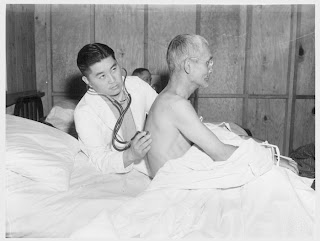I can't portray or even know where to begin trying
to share Heart Mountain and all that it was to the
Japanese immigrants and yes, Japanese American citizens interred there.
Here are some pictures of today and then when this "city"
was inhabited by over 10000 human beings.
Maybe it will enlighten and add curiosity to look further.
8123 ft. It is between
Cody and Powell Wyoming.
On February 19, 1942 President Roosevelt
signed Executive Order 9066.
The E.O. authorized the removal of any or all people from military areas "as deemed necessary or desirable." The military in turn defined the entire West Coast, home to the majority of Americans of Japanese ancestry or citizenship, as a military area. By June, 1942 more than 110,000 Japanese Americans were relocated to remote internment camps built by the U.S. military in scattered locations around the country. For the next two and a half years, many of these Japanese Americans endured extremely difficult living conditions and poor treatment by their military guards.
A dark time in our history resided in the Heart Mountain shadow
for over three years from August 11, 1942
to November 10, 1945.
It was the Heart Mountain Internment Camp
The young Japanese boy was one
of 10767 Japanese and Japanese American
internnees. The internees sent here at Heart Mountain Wyoming
came from Pomona, Santa Anita, California,
Portland Oregon and Washington state.
Heart Mountain and internment barracks can be seen
in the background.
Families arriving Heart Mountain via
train travelled from California, Oregon and Washington.
shows their locations.
Over 110,000 Japanese immigrants and Japanese Americans,
including whole familes, men, women and children and some from
multiple generations were rounded up and shipped to these camps.
Those interred were business owners, families,community leaders
and for many - American citizens.
They were readied for transport in 1-2 weeks, either sold their homes and
businesses cheap or lost them totally. Loaded onto trains and shipped to
one of ten internment camps shown above.
Heart Mountain Wyoming camp became the third largest city
in Wyoming.
An internment barrack remains
at Heart Mountain. The camp was
closed in 1945
Pictured is George Hirahara who was interred in 1942
to Heart Mountain from Yakima Washington.
He was able to build and setup his own darkroom
at the Relocation Center and took and kept
over 2000 photos that will soon be available
at the Washington State University Library of
camp life has he saw it.
Japanese American boy scouts
during the raising of the American flag each
day at Heart Mountain
Todays view of the Heart Mountain Interment camp
and all that remains.
The above link is to the Heart Mountain Foundation.
The chimney in the background was the location
of the camp hospital which was staffed largely
by Japanese within the camp who had were professionals
prior to their internment.
A view of an internment camp street
with Heart Mountain in the background
Heart Mountain Hospital care
by Japanese doctors who also were interred.
Farming near the camp was allowed.
As the camp members became trusted by many
of the local farmers, they were used to help
harvest local products as well. The locals from the
Cody and Powell Wyoming area initially did not want the
Internment camp near them at all.
This plaque on the Heart Mountain
Internment camp grounds honors those
15 killed and named on the plaque the 799 who served.
near the main gate that listed the names of all of its 799 soldiers,
fifteen of whom were killed and 52 wounded in battle.
Norman Mineta, distinguished
Japanese American born in San Jose CA
in 1931 was an internee at the Heart Mountain
Interment Camp. Mr. Mineta served Presdents
Clinton and Bush as Secretary of Commerce and
Transportation
Below is National Park Service link that provides
further narrative on the Relocation process that began
in 1942 for the Japanese American civilians to ten
camps in the U.S. away from the West Coast
I was born in 1942 and my father served in Naval combat in the Pacific. He remains alive today at almost 93. If he viewed this section he may have memories of a different view however, no matter anyone's view of that dark time, it is our history and hopefully we learned that we too
could be inhumane even though we felt justified. Hopefully we
won't forget that. dl
















No comments:
Post a Comment
Note: Only a member of this blog may post a comment.